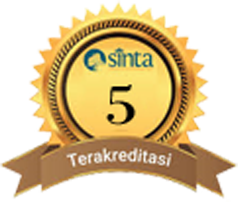PENERAPAN REWARD AND PUNISHMENT DALAM MENINGKATKAN KEDISIPLINAN DAN HASIL BELAJAR SISWA PADA KEGIATAN PEMBELAJARAN TEMATIK KELAS II MIN 1 SABANG
DOI:
https://doi.org/10.22373/fitrah.v4i2.2547Abstract
Discipline is one of the factors that can affect the improvement of learning outcomes. However, there are still many students who are not aware of the importance of discipline in the learning process such as students not doing assignments or copying friends' assignments, this results in many students whose grades do not reach the Minimum Completeness Criteria (KKM). One of the strategies implemented to improve discipline and learning outcomes is by giving reward and punishment. The aims of this study were: (1) to find out the activities of teachers and students after applying reward and punishment in class II/b, (2) to find out the level of discipline and student learning outcomes after implementing reward and punishment in class II/b. This type of research is Classroom Action Research (PTK) which is carried out in 4 stages, namely planning, action, observation, and reflection. The research instrument was in the form of teacher activity observation sheets, student activity observation sheets, disciplinary observation sheets, and student learning outcomes test sheets. The results showed that (1) the percentage of teacher activity research results in cycle I was 77.77% in the good category and increased in cycle II to 89% in the excellent category, (2) the percentage of student activity research results in cycle I was 78 .85% in the good category and in cycle II it becomes 89% in the very good category, (3) the percentage of student discipline in cycle I is 76% in the good category and in cycle II it becomes 80% in the good category, (4) the percentage of learning outcomes students in cycle I, namely 62% in the good category and experienced an increase in cycle II to 92% in the very good category. Based on the results of these data it can be concluded that the application of reward and punishment can improve discipline and student learning outcomes in thematic learning activities for class II students MIN 1 Sabang.
References
Hamzah, Menjadi Penelitian PTK yang Profesional, (Jakarta: Bumi Aksara, 2011),
Hasil Observasi Awal di MIN 1 Sabang, Tanggal 24 Januari 2022
Kunandar, Penelitian Tindakan Kelas, (Jakarta: Raja Grafindo Persada, 2012),
Kurniawati, “Peningkatan kedisiplinan melalui metode reward and punishment pada siswa kelas 2 SDN Keputran”. FOUNDASIA, Vol 12, No 12, 2021,
M. Sastra Pradja, Kamus Istilah Pendidikan & Umum, (Surabaya: Usaha Nasional, 1973,
Mahmud Shalahuddin, dkk, Metode Penelitian Agama, (Surabaya: Bina Ilmu 1987),
Malik Fajar, Holistika Pemikiran Pendidikan, (Jakarta: Raja Grafindo, 2005),
Ni Nyoman Febriana Pradnya Sari, “Pemberian Reward dan Punishment untuk Meningkatkan Kedisiplinan Siswa pada Pembelajaran IPS Kelas V SD Negeri 1 Kejobong Purbalingga”, Skripsi PGSD, (Mataram: Fakultas Ilmu Pendidikan Universitas Mataram, 2017),
P. Joko Subagyo, Metode Penelitian dalam Teori dan Praktek. (Jakarta: Rineka Cipta. 2004),
Pramudya Ikranagara, “Pemberian Reward dan Punishment untuk Meningkatkan Kedisiplinan Siswa pada Pembelajaran IPS Kelas V SD Negeri 1 Kejobong Purbalingga”, Skripsi PGSD, (Yogyakarta: Fakultas Ilmu Pendidikan Universitas Negeri Yogyakarta, 2014),
Rochita wiria Atmadja, Metode Penelitian Tindakan Kelas, untuk Meningkatakan Kinerja Guru dan Dosen, Cet. III, (Bandung, 2007),
Suharsimi Arikunto, dkk, Penelitian Tindakan Kelas, (Jakarta: Bumi Aksara, 2011),
Suyadi, Panduan Penelitian Tindakan Kelas, (Yogyakarta: Diva Press, 2013),
Tulus Tu’u, Peran Disiplin Pada Perilaku dan Prestasi Siswa, (Jakarta: Grasindo, 2002),
Wuri Wuryandani, dkk., “Pendidikan Karakter Disiplin di Sekolah Dasar”. Cakrawawala pendidikan”, vol XXXIII, No 2, 2014,
Downloads
Published
How to Cite
Issue
Section
License
Authors who publish in this journal agree to the following terms:
- Authors retain copyright and grant the journal right of first publication with the work simultaneously licensed Attribution-NonCommercial-ShareAlike 4.0 International (CC BY-NC-SA 4.0) that allows others to share the work with an acknowledgment of the work's authorship and initial publication in this journal.
- Authors can enter into separate, additional contractual arrangements for the non-exclusive distribution of the journal's published version of the work (e.g., post it to an institutional repository or publish it in a book), with an acknowledgment of its initial publication in this journal.
- Authors are permitted and encouraged to post their work online (e.g., in institutional repositories or on their website) before and during the submission process, as it can lead to productive exchanges and earlier and greater citation of published work. (See The Effect of Open Acces)









